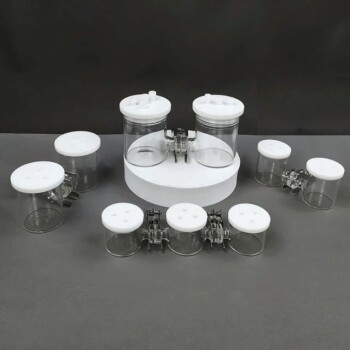The H-type electrolytic cell is a unique electrochemical cell that consists of two connected electrochemical cells. It features a replaceable membrane seal, multiple electrode feedthroughs, and gas inlet/outlet for easy degassing. Electrolysis, a process that uses electrical energy to drive a non-spontaneous redox reaction, is frequently employed to break down chemical substances. An H-type electrolytic cell is used for electroplating and to break down typically stable or inert chemical substances in solution.
Toggle Categories
Get Instant Support
Choose your preferred way to connect with our team
-
Get Free Quote Fill out form for detailed pricing
-
Send Email Detailed inquiry support
-
WhatsApp Quick mobile chat
Response Time
Within 8 hours on working days, 24 hours on holidays
h type electrolytic cell

H-Type Double-Layer Optical Electrolytic Electrochemical Cell with Water Bath
Item Number : ELCHD
$269.00
We have the best H Type Electrolytic Cell solutions available in the market. Our extensive portfolio guarantees that we have an appropriate standard solution that will meet your needs
Applications of H Type Electrolytic Cell
- Production of high-purity aluminum
- Electrorefining of non-ferrous metals such as copper and zinc
- Electrowinning of metals
- Electroplating of metals such as copper, nickel, and chromium
- Decomposition of chemical compounds like water into hydrogen and oxygen
- Production of caustic soda
Advantages of H Type Electrolytic Cell
- The H-type replaceable membrane sealed electrolytic cell is featured with replaceable membrane seal, a gas inlet and outlet for easy degassing, and multiple electrode feedthroughs for working electrodes, counter electrodes, and reference electrodes.
- This type of cell provides greater stability and accuracy in electrochemical experiments due to its sealed design.
- The H-type electrolytic cell allows for greater flexibility in electrode placement, which enables more complex experiments to be conducted.
- The replaceable membrane seal feature of this type of cell allows for easier maintenance and repairs, which reduces downtime in the lab.
- H-type electrolytic cells are widely used in research and industrial applications due to their high efficiency in producing high-purity metals and other materials.
Our H Type Electrolytic Cell is a cost-effective and highly customizable solution for your laboratory needs. With our custom design service, we can cater to your specific requirements, ensuring that you get the exact product you need.
FAQ
What Is The H Type Of Electrochemical Cell?
What Is H-cell Used For?
What Is The H Type Microbial Fuel Cell?
How Many Types Of Electrolytic Cells Are There?
What Is The H Cell For Hydrogen Permeation Experiments?
REQUEST A QUOTE
Our professional team will reply to you within one business day. Please feel free to contact us!
Related Articles

The Glass Heart of the Experiment: Precision Through Systematic Care
Routine maintenance of double-layer electrolytic cells isn't just cleaning—it's calibration. Discover the systematic protocol for reproducible electrochemical data.

The Thermodynamic Paradox: Balancing Precision and Safety in Electrolytic Cells
Master temperature control in double-layer water-bath electrolytic cells. Understand material limitations, prevent thermal damage, and ensure data integrity.

The Thermodynamics of Consistency: Mastering the Invisible Variable in Electrolysis
Discover why temperature is the silent killer of electrochemical precision. Learn how double-layer electrolytic cells engineer thermal stability for repeatable results.

The Art of the Empty Vessel: Preparing Quartz Electrolytic Cells for Absolute Precision
Reliable electrochemical data isn't just about the reaction; it's about the setup. Discover the systematic approach to preparing quartz cells for perfect fidelity.

The Thermodynamics of Patience: Preventing Electrolytic Cell Overload
Overloading an electrolytic cell isn't just an error; it's a systemic failure. Learn the physics of safety, the risks of excess energy, and how to maintain control.

The Architecture of Precision: Mastering the Five-Port Water Bath Electrolytic Cell
Mastering the electrolytic cell is not just about chemistry; it is about discipline. Learn the systematic approach to preparation, operation, and maintenance.

The Geometry of Truth: Why the Maintenance of Your Optical Electrolytic Cell Defines Your Data
Great data isn't just about the experiment; it's about the vessel. Learn the rigorous maintenance protocols for side-window optical electrolytic cells.

The Quiet Discipline: Mastering the Post-Use Protocol for Five-Port Electrolytic Cells
Learn the methodical post-use care for five-port water bath electrolytic cells. Prevent corrosion, ensure safety, and protect your experimental data.

The Architecture of Reaction: Selecting the Right Electrolytic Cell Body
Discover how cell volume and sealing impact electrochemical data. Learn to balance scarcity, scale, and sensitivity with the right lab equipment choices.

The Architecture of Control: Mastering the Super-Sealed Electrolytic Cell
Precision in electrochemistry isn't just about theory; it's about mechanical discipline. Learn the critical protocols for super-sealed electrolytic cells.

The Architecture of Invisible Containment: Why Material Choice Defines Electrochemical Precision
Explore the strategic engineering behind High Borosilicate Glass and PTFE in electrolytic cells—balancing visibility with absolute chemical inertness.

The Thermodynamics of Precision: Mastering the Double-Layer Electrolytic Cell
Precision isn't accidental. Discover the methodical operation of double-layer electrolytic cells, where thermal stability and rigid setup define success.

The Silent Variable: Engineering Reliability in Electrolytic Cells
Data accuracy depends on equipment integrity. Learn the engineering protocols for maintaining electrolytic cells to prevent systemic error.

The Quiet Architecture of Clarity: Preserving Side-Window Optical Cells
Learn the precise protocols for storing optical electrolytic cells. Prevent thermal degradation, chemical etching, and data drift with expert maintenance strategies.

The Silence of the Seal: Why Electrochemical Precision is a Battle Against the Atmosphere
Precision in electrochemistry isn't just about voltage; it's about isolation. Discover how super-sealed cells defeat contamination and define reproducibility.

The Silent Partner: Why Material Choice in Electrochemistry is a Matter of Trust
Discover why high borosilicate glass and PTFE are the non-negotiable standards for electrolytic cells. A deep dive into material science for precise data.

Your Induction Furnace Is Failing You. The Reason Isn't What You Think.
Struggling with inconsistent melts or high costs? The problem may be a fundamental mismatch in your induction furnace type. Learn to fix it.

The Art of the Non-Spontaneous: Precision in Electrolytic Circuits
Mastering the electrolytic cell setup requires more than connecting wires. It demands a systematic approach to polarity, purity, and power control.

Glymercury Electrode: Composition, Characteristics, and Applications
An in-depth look at the glymercury electrode, its composition, characteristics, and applications in analytical chemistry.

Use and Care of Reference Electrodes
Detailed guide on the use, calibration, and maintenance of reference electrodes in electrochemical studies.

